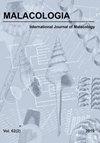用基于聚结的划界方法评估淡水蜗牛科的物种边界
IF 1
4区 生物学
Q4 ZOOLOGY
引用次数: 0
摘要
摘要几个淡水蜗牛科的一个共同问题是,对于一些属来说,物种划界的标准很少,受到种内和个体发生变异的影响,或者不够离散,无法明确区分物种。对于这些属,分子方法的使用对于识别有效物种是决定性的。在此,我们应用联合方法来界定Physidae中的进化重要单元(ESU)。我们使用了GenBank中可获得的线粒体细胞色素氧化酶亚基I(COI)基因的496个序列,归属于6个属和25个标称物种,以及具有两个标准(单阈值和多阈值)的算法GMYC(通用混合Yule聚结),PTP(泊松树过程)和mPTP(多速率树泊松过程)。表现出最佳性能的方法是mPTP。该方法显示出更高的分类物种恢复频率,并限定了较低数量的ESU(25个ESU来自25个标称物种的数据集)。Physidae是一个淡水蜗牛科,它提出了几个与物种边界识别有关的问题。在此,联合划界方法的使用使我们能够解决重要的分类学问题,为未来的分类学研究开辟了新的途径。我们的研究结果表明,用于界定几个有效物种的形态学操作标准在种内变异的范围内,表明该科的分类学膨胀。我们的研究结果还表明,在名义物种尖尾藻(Draparnaud,1805)、詹内西白灵藻(Dall,1919)、波米利毛藻(Conrad,1834)和吉氏毛藻(Say,1821)下存在隐性多样性。本文章由计算机程序翻译,如有差异,请以英文原文为准。
Assessing Species Boundaries in the Freshwater Snail Family Physidae Using Coalescent-Based Delimitation Methods
ABSTRACT A common issue for several freshwater snail families is the fact that, for some genera, the criteria for species delimitation are scarce, subjected to intraspecific and ontogenetic variation, or insufficiently discrete to allow a clear distinction between species. For these genera, the use of molecular approaches is decisive in recognizing valid species. Herein, we applied coalescent methods to delimit evolutionary significant units (ESUs) in Physidae. We used 496 sequences of the mitochondrial cytochrome oxidase subunit I (COI) gene available in GenBank, ascribed to six genera and 25 nominal species, and the algorithms GMYC (General Mixed Yule-Coalescent) with two criteria (single-threshold and multiple-threshold), PTP (Poisson Tree Process), and mPTP (multi-rate Tree Poisson Process). The method that presented the best performance was the mPTP. This method showed a higher frequency of taxonomic species recovery and has delimited a lower number of ESUs (25 ESUs from a dataset attributed to 25 nominal species). Physidae is a family of freshwater snails that presents several issues related to the recognition of species boundaries. Herein, the use of coalescent delimitation methods allowed us to address important taxonomic questions, opening new avenues for future taxonomic research. Our findings have shown that the morphological operational criteria used to delimit several valid species fall within the limits of intraspecific variability, demonstrating taxonomic inflation within this family. Our results also demonstrated the presence of cryptic diversity under the nominal species Physella acuta (Draparnaud, 1805), Beringophysa jennessi (Dall, 1919), Physella pomilia (Conrad, 1834), and Physella gyrina (Say, 1821).
求助全文
通过发布文献求助,成功后即可免费获取论文全文。
去求助
来源期刊

Malacologia
生物-动物学
CiteScore
2.00
自引率
0.00%
发文量
15
审稿时长
3 months
期刊介绍:
Malacologia publishes papers on all groups of the Mollusca. Malacologia specializes in publishing long papers and monographic treatments. Complete data are especially appreciated. Papers must be of interest to an international readership. Papers in systematics, ecology, population ecology, genetics, molecular genetics, evolution and phylogenetic treatments are especially welcomed. Also welcomed are letters to the editor involving papers published or issues of import to science of the day.
 求助内容:
求助内容: 应助结果提醒方式:
应助结果提醒方式:


